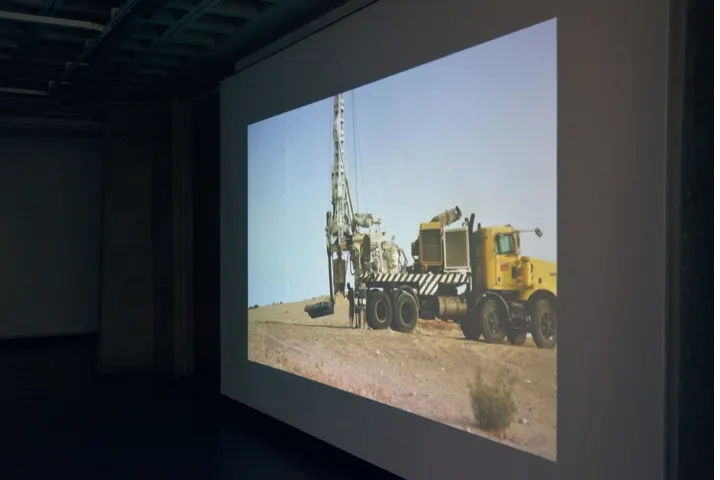

A still from the video presentation 'In The Desert', which according to the curator 'can be seen as a comment on this policy of ‘dumping’ Eastern immigrants in the midst of the wilderness'
<p>
<strong>Any art is a reflection of the artist&rsquo;s experience and emotions. This is amply evident at the ongoing multimedia show &ldquo;In Another Green&rdquo; at the Galerie Romain Rolland presented by Alliance Francaise de Delhi in collaboration with the Embassy of Israel.</strong></p>
<p>
The participating artists Joseph Dadoune and Leor Grady are from Israel belonging to &ldquo;Eastern&rdquo; Jewish communities (Mizrahi Jews), with the latter being a second generation to Yemeni immigrants while the former tracing his roots to Algeria and France and who migrated with his mother.</p>
<p>
The curator is Achia Anzi, New Delhi-based Israeli artist and assistant professor of visual arts and the BFA program director at Jindal School of Liberal Arts and Humanities, OP Jindal Global University, Sonipat.</p>
<p>
Entering the show, one is greeted by a large screen showing Dadoune&rsquo;s video &ldquo;In The Desert&rdquo; which gives a fair idea about the exhibition. With the aid of a truck mounted machine two holes are drilled in the desert in which two uprooted trees &ndash; cypress and palm — are unloaded. Following this the holes are covered with soil, with concrete blocks placed on them signifying complete burial.</p>
<p>
Through symbolism Dadoune has highlighted the moving of the migrants to Israel and as per curator&rsquo;s note, &ldquo;the video can be seen as a comment on this policy of &lsquo;dumping&rsquo; Eastern immigrants in the midst of the wilderness&rdquo;.</p>
<p>
Dadoune&rsquo;s other video, &ldquo;Phoenix I and II&rdquo; also brings to the fore this aspect of migration. In the first the artist is seen hanging from a crane that lifts him on top of a tree on the outskirts of Ofakim (Israel) while II shows his closeup hung between sky and earth. &ldquo;The migratory uprootedness is projected in these videos both as a problem and a solution. The phoenix represents death but also a rebirth and a new beginning,&rdquo; says Anzi.</p>
<p>
<img alt="" src="https://www.indianarrative.com/upload/news/Untitled_Carpet.jpg" style="width: 367px; height: 489px;" /></p>
<p>
One work which gets instant attention is Grady&rsquo;s &ldquo;Untitled&rdquo; that includes a carpet with a gaping portion cut out in the centre, which is hung on the wall. The wall hanging reveals the outline of a region giving it a map-like form. According to Anzi the carpet installation &ldquo;evokes the story of the Yemeni of Kinneret, a group of Yemeni immigrants who were invited by the Zionist leadership to settle o the shore of the Sea of Galilee in 1912 but were later forced to leave by the kibbutz members of Kvutzat Kinneret.&rdquo;</p>
<p>
He explains further: &ldquo;The carpet is associated with the Israeli consciousness with the Yemeni immigration to Israel, the cut-out in the shape of the Sea of Galilee accentuates an erasure and a void.&rdquo;</p>
<p>
These works spotlight on the show&rsquo;s theme — notion of coloniality in Israel and the relation between Western and Eastern Jews through the theme of nature. &ldquo;The artworks on display engage with the Western perception that non-Western societies are closer to the state of nature, or in other words primitive&hellip; The title was taken from the poem &lsquo;Preliminary Background Remarks&rsquo; by the Algeria-born Israeli poet Erez Biton that projects the conflicted position of the poet who is trapped, as it were, between Eastern and Western traditions.&rdquo;</p>
<p>
<img alt="" src="https://www.indianarrative.com/upload/news/Dadoune_Drawings.webp" style="width: 720px; height: 480px;" /></p>
<p>
One wall is adorned with 20 drawings by Dadoune with bold and expressive strokes, all expressing migration and the problems it entails. The curator&rsquo;s note states: &ldquo;This migratory approach is apparent in the drawings he created after the passing away of his mother, where he inscribes the words &lsquo;immigration&rsquo;, &lsquo;exile&rsquo;, &lsquo;passages&rsquo; over her Israeli passport and her immigration related application forms.&rdquo; About the flower, the central motif in these drawings, Anzi says: &ldquo;Dadoune&rsquo;s flowers contrast with Zionist symbols drawn from the plant kingdom. While the representations of local flora in Zionist art signify a sense of rootedness and belonging, in Dadoune&rsquo;s visual vocabulary the flower becomes a metaphor for uprootedness, exile and nomadism.&rdquo;</p>
<p>
<img alt="" src="https://www.indianarrative.com/upload/news/Bouquets_Series.jpg" style="width: 720px; height: 480px;" /></p>
<p>
Grady too uses flora as is evident from the &ldquo;Bouquets&rdquo; photograph series showing six images of herb plants which are traditionally cultivated by Yemini Jews for religious and secular purposes. Tied with a ribbon, the plant gives the appearance of a bouquet. &ldquo;Grady photographs the plants in a manner that underline their useability or what Heidegger calls readiness-to-hand and their relation to the being-in-the-world of his community,&rdquo; remarks Anzi.</p>
<p>
<img alt="" src="https://www.indianarrative.com/upload/news/Eye_And_Heart.jpg" style="width: 720px; height: 480px;" /></p>
<p>
The third video Grady&rsquo;s &ldquo;Eye and Heart&rdquo; is a very evocative work as it shows two pairs of dancers performing fluidly and naturally to the rhythm of the beats on a tin container. Elaborating, Anzi observes: &ldquo;It is titled after a poem by the Yemeni mystic Rabbi Shalom Shabazi (17th Century) which was written in the form of a dialogue between the eye and the heart. In the video, Grady juxtaposes a pair of professional dancers who studied the Yemeni Jewish dance through watching videos (the knowledge of the eye) and a Yemeni youth who learned the dance intuitively through tradition (knowledge of the heart).&rdquo;</p>
<p>
<em>(The show is on till December 23, 11 a.m. to 7 p.m.)</em></p>
Follower of the Dalai Lama expressed their elation at his statement that Gaden Phodrang Trust…
The Foreign ministers of the Quad nations met in Washington, DC, on July 1 to…
Ahead of the Dalai Lama's 90th birthday celebration, the Tibetan Buddhist oracle, Nechung, comes in…
The Union Cabinet, chaired by Prime Minister Narendra Modi, on Tuesday approved the National Sports…
Residents of Muzaffarabad in Pakistan-occupied Jammu and Kashmir (PoJK) are grappling with ongoing disruptions in…
Residents across Pakistan's Karachi continue to grapple with a worsening water shortage, as electricity supply…